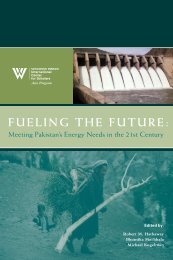"Mostly Propaganda in Nature:" Kim Il Sung, the Juche Ideology, and ...
"Mostly Propaganda in Nature:" Kim Il Sung, the Juche Ideology, and ...
"Mostly Propaganda in Nature:" Kim Il Sung, the Juche Ideology, and ...
You also want an ePaper? Increase the reach of your titles
YUMPU automatically turns print PDFs into web optimized ePapers that Google loves.
"<strong>Mostly</strong> <strong>Propag<strong>and</strong>a</strong> <strong>in</strong> <strong>Nature</strong>:" <strong>Kim</strong> <strong>Il</strong> <strong>Sung</strong>, <strong>the</strong> <strong>Juche</strong> <strong>Ideology</strong>, <strong>and</strong> <strong>the</strong> Second Korean War<br />
NKIDP Work<strong>in</strong>g Paper #3<br />
The Second Korean War<br />
Korea has been one of <strong>the</strong> "hottest" of <strong>the</strong> proverbial Cold War hot spots s<strong>in</strong>ce its<br />
division at <strong>the</strong> end of World War II. Tens of thous<strong>and</strong>s died <strong>in</strong> skirmishes even before North<br />
Korean forces crossed <strong>the</strong> 38 th parallel <strong>in</strong> 1950. Although <strong>the</strong> fight<strong>in</strong>g officially ended <strong>in</strong> 1953,<br />
tensions have persisted. In August 1955, DPRK anti-aircraft artillery downed an American T-6<br />
tra<strong>in</strong><strong>in</strong>g aircraft, kill<strong>in</strong>g one man. Three years later, <strong>the</strong>y shot down an F-86 Sabre Jet that strayed<br />
over <strong>the</strong> restricted zone, hold<strong>in</strong>g <strong>the</strong> pilot prisoner briefly before return<strong>in</strong>g him to <strong>the</strong> United<br />
States. Nor<strong>the</strong>rn rhetoric was even more belligerent. DPRK children, claimed Pyongyang Radio<br />
<strong>in</strong> 1959, were be<strong>in</strong>g kidnapped <strong>and</strong> sold to <strong>the</strong> United States, where "most of <strong>the</strong>m were divided<br />
among American capitalists <strong>and</strong> plantation owners, <strong>and</strong> many children died while <strong>the</strong>y were<br />
be<strong>in</strong>g sold around like animals <strong>in</strong> <strong>the</strong> foreign l<strong>and</strong>." 48 Yet, despite <strong>the</strong> occasional flare-up, <strong>the</strong><br />
overall level of violence decl<strong>in</strong>ed dramatically after <strong>the</strong> 1953 Armistice. Incidents along <strong>the</strong><br />
DMZ still occurred but to some extent it was <strong>the</strong>ir very <strong>in</strong>frequency that seemed to make <strong>the</strong>m<br />
newsworthy. American soldiers mann<strong>in</strong>g <strong>the</strong> demilitarized zone (DMZ) still faced dangers,<br />
wrote <strong>the</strong> New York Times <strong>in</strong> 1962, but s<strong>in</strong>ce <strong>the</strong> North seemed to have adopted a "soft, pro-<br />
coexistence l<strong>in</strong>e," such service was now considered "generally tedious." 49<br />
The calm, however, began to fade <strong>in</strong> <strong>the</strong> mid-1960s. The explosion of violence started <strong>in</strong><br />
late 1966, when <strong>Kim</strong> began send<strong>in</strong>g guerrillas <strong>in</strong>to South Korea for <strong>the</strong> first time s<strong>in</strong>ce <strong>the</strong><br />
Korean War. The relative stability along <strong>the</strong> DMZ was soon shattered. Military <strong>in</strong>cidents grew<br />
from 42 <strong>in</strong> 1965 to 286 <strong>in</strong> just <strong>the</strong> first 6 months of 1967, <strong>and</strong> mutual exchanges of gunfire across<br />
48 Wash<strong>in</strong>gton Post, June 8, 1959, p. 6.<br />
49 New York Times, November 23, 1962, p. 28.<br />
www.wilsoncenter.org/nkidp 18

















